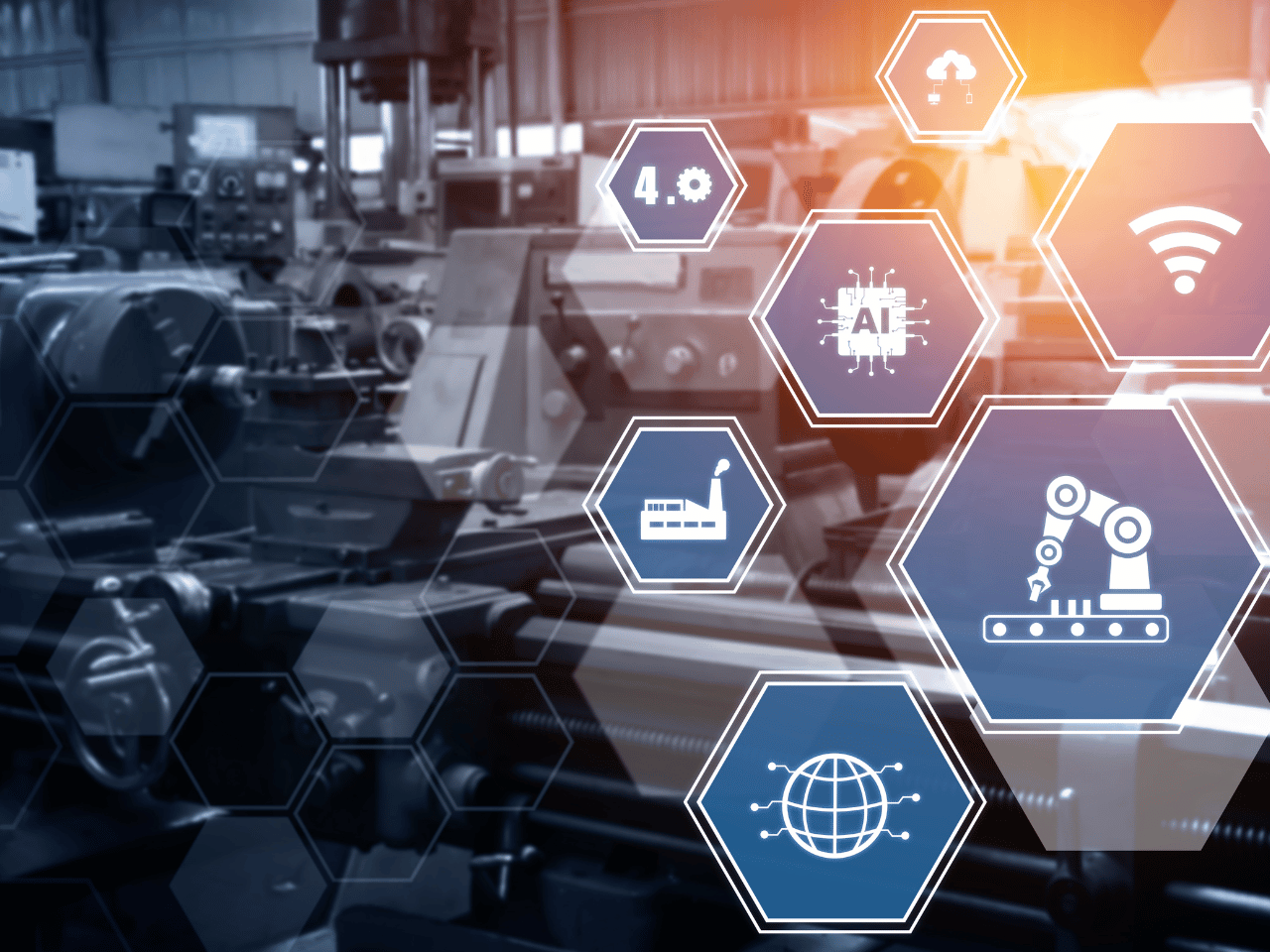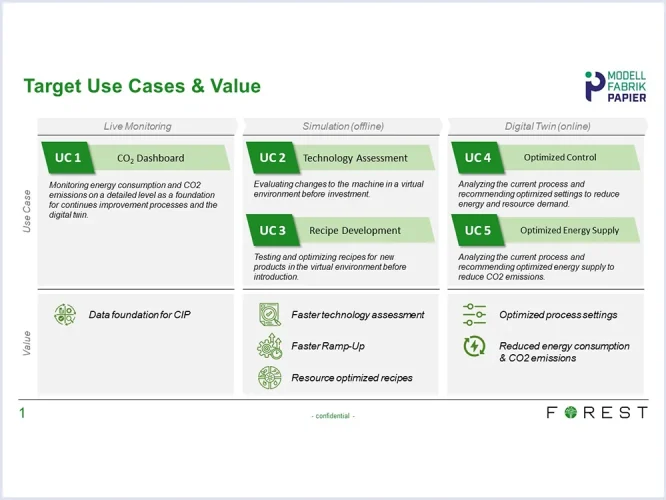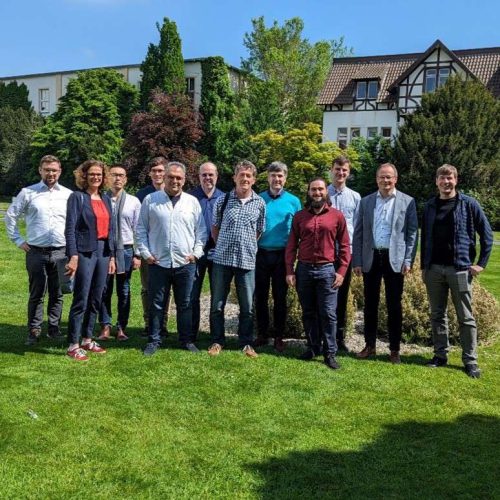FOREST – Designing a digital twin for the paper industry
- News
- -
- FOREST – Designing a digital twin for the paper industry

Digital twins are a smart solution in industry 4.0. The FOREST research project is developing such a framework for climate-neutral paper production.
The task of making paper production more sustainable and climate-friendly is extremely complex. Since the highly automated manufacturing process involves closely coordinated manufacturing stages, disruptive changes are needed to significantly reduce energy consumption and CO2 emissions in paper production and to save natural resources. To achieve this, a large number of process steps that are interdependent in terms of energy need to be redesigned or, in some cases, need to be developed from scratch. However, the paper industry still lacks an approach that digitally maps the entire system of a paper machine. This is where the FOREST research project of Modellfabrik Papier comes in.
“Together with our shareholders ABB and Voith and our research partners from the Institute NOWUM Energy at the FH Aachen, the Institute for Textile Technology at RWTH Aachen University, the Papiertechnische Stiftung (PTS) and the Chair of Wood Technology and Fibre Materials Technology at the TU Dresden, we are developing a framework for digital twins of paper production,” explains Philip Kayser, project coordinator of the FOREST project at Modellfabrik Papier.
This virtual image of physical assets in a real paper factory maps and simulates the energy and material flows down to the sub-process and product level, from stock preparation to winding. The simulation visualizes the physical processes in the actual state of a paper machine and allows to compare it with the ideal state simulated.
“The framework is designed to achieve several objectives. Among other things, we want to support machine operators and process engineers in continuously optimising the operating mode and energy supply. In addition, however, we also want to explore the optimisation potential in order to evaluate the benefits of investment-intensive, disruptive plant changes before they are implemented,” says Kayser. In addition, the framework, which enables the detailed recording of energy consumption and CO2 emissions, can be used to define requirements for future developments.
“The concept of the digital framework makes it possible for the first time to optimise the entire system.”
Key concept for the paper industry 4.0
In addition to gathering data on current consumption and emissions, a key objective of the digital twin is to predict them. In the simulation, energy supply, operating mode and raw materials can be varied so that the effects of different changes on the process can be analysed. This is a real novelty: For the first time, the complex relationships in the paper manufacturing process can be grasped in their entirety. Process engineers will be able to better assess and optimise the current operating mode of their plant. It will also facilitate the development of new recipes and supports ecosystem integration.
Use cases and a first demonstrator
In the first stages of the research project – based on workshops with the associated partners, the potential users of the framework – various use cases were designed, since it is vital to take the different needs of the users, which vary depending on the mill and paper grade, into account. In addition, paper machines are sometimes in operation for decades, are continuously being developed and often converted. As a result, the state of the art of today’s paper machines is very diverse.
“That’s why we are pursuing a modular approach in FOREST,” says Kayser. The importance of this open concept was emphasised again in in-depth discussions with process engineers and experts, aiming at the efficient scaling of possible use cases. One interesting use case, for example, is the integration of a heat pump into the steam supply system. The digital twin should therefore be easy to adapt to structural changes in order to be able to capture their consequences in advance and better evaluate any investments.
A first demonstrator with a dashboard has been developed, offering basic functionalities, such as the adjustment of energy supply, control variables and machine parameters. The simulation provides information on energy consumption and CO2 emissions of the various processes and shows the CO2 footprint of the final product. Since the current standards, such as the GHG Protocol, do not specify this level of detail yet, the user can choose between different accounting approaches.
Modelling the dryer section
In order to bring the framework to life, simulation models for the individual machine sections are being developed in further work packages. The focus is initially on the dryer section. The aim is to divide material properties, steam and air systems and energy supply into individual submodels in a suitable way so that the modelling can later be easily adapted to any dryer section. A major challenge here is the high complexity of the material properties and the drying process. It is essential to consider the material properties of the paper web in the process steps, because changes in the operating mode affect the paper properties, while the ultimate quality of the final product may not be compromised.
Further development of the architecture for decentralised research work
Since the individual sub-process models – such as the one for the dryer section – are developed by different partners in the research project, and should later be interchangeable and expandable with other models from other entities, standardisation of the simulation models and interfaces is necessary. The Asset Administration Shell is ideally suited for this purpose. In the first steps, the division into various submodels of the asset administration shell for products, machine sections and simulation models was discussed. These now need to be further developed.
Furthermore, the submodels are being developed by the individual research partners in a wide range of simulation environments. To enable the models to interact seamlessly, the framework development is based on functional mock-up units (FMUs).
Cloud solution planned for the application
In order to pilot and validate the complete prototype at a later date, it will be implemented in the cloud. This solution offers a number of advantages: the digital twin can be set up more easily for new machines, maintained more efficiently and developed further. Since many paper manufacturers are already connected to cloud environments – albeit to varying degrees – this approach offers a high degree of flexibility.
Next steps
“In recent months, the foundations for the FOREST framework have been laid in the various work packages,” says Kayser after the latest project partner meeting. Now it is time to develop these and put the individual pieces of the puzzle together. The next milestone has been set: next year, the research team wants to present a proof of concept.
In the FOREST research project of the Modellfabrik Papier , a consortium of two shareholders (ABB, Voith), four research partners (PTS, TU Dresden, RWTH and FH Aachen) and associated partners (Felix Schoeller, Schoellershammer, Sappi, Wepa) is developing a digital twin for the paper industry.
Discover more news
Do you have any questions?
Feel free to contact us if you would like to find out more about Modellfabrik Papier, our tasks and our projects.
Discover more news
Learn more about us
Do you have any questions?
Feel free to contact us if you would like to find out more about Modellfabrik Papier, our tasks and our projects.

